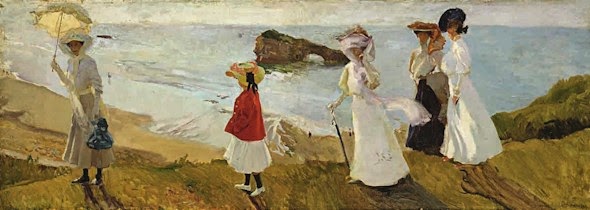 |
| Paseo por el faro. Biarritz, 1906 |
I had some free time, which was
enough to visit the exhibition “Sorolla y Estados Unidos” in the Sala Recoletos of Fundación Mapfre. My friend
Angélica (also a great painter) and I have a great admiration for Sorolla in
common. I can’t tell how long we could have been copying his paintings, trying
to imitate his waves, his malves… She had already visited it in San Diego and
since we couldn’t enjoy it together, at least we could be in front of the same
paintings, despite being in different timezones and continents. I had to
fulfill my promise and, while I drink my coffee, with my impressions still
fresh, I’m writing this blog post to share them with all of you.
The main driving force is the
relationship between the artist and the United States, including some studies
for Hispanic Society’s decoration project, his New York gouaches, his drawings
of the menus he would eat, artworks he sold there and that are hardly ever
brought to Spain… all of them impressing. Especially the strength of his
brush-strokes, that practically makes his painting a low relief. He always
would use more material on the relevant, the light and the faces of the
painting. It’s also impressing his color range, how he adds a smear of Veronese
Green on a sleeve - you’ve got to be quite brave to do that - or leaving the
kids playing in the sea’s faces as a sketch.
 |
| Triste herencia, 1899 |
I was principally looking forward
to getting in front of 4 specific paintings. The copies aren’t ever loyal to
the original. I had a great interest in “Triste herencia”. I tried to get a
look of it in Valencia in 2009, but we weren’t allowed to. Why did Monet say
when he saw it that he was a master of light? And why precisely Monet? The
copies do not really show the whole greatness of this painting. He did win
1900’s Gran Prix for something: he shows pity and respect towards the orphan
kids in the Asilo de San Juan de Dios. He was orphan himself: had he thought he
had had better luck than the kids on his canvas? The skinny and sick bodies are
full of mauve, carmine, orange and green, which are in contrast with the
priest’s plain gray on his soutane. In Sorolla’s paintings, it’s a must to
focus, not only on the light details and whites, but also on his grays and
blacks, like the ones in the suit on Beruete’s portrait or on Hispanic
Society’s ”Los Nazarenos”.
 |
| Otra Margarita, 1892 |
I also wanted to take look at “Otra
Margarita”, another rewarded painting, this one in 1892. With a few strokes, he
shows us the lost look of an infanticide. Her cuffed hands are barely visible.
And then again, the light reflecting on the wagon’s walls. (Sorolla asked to be
provided one in El Grao to paint it from nature).
 |
| Los pimientos, 1903 |
As a third one, which is unfairly
treated by the copies is “Los pimientos”. A red smear suggests the idea of
peppers and the light beam on the girl’s sleeve is a brush-stroke with a whole
load of white painting. (If this is not an ‘Action Painting’ in 1903…). It’s a
painting that can remind us of Prado’s “Y aún dicen que el pescado es caro” for its composition.
 |
| Louis Comfort Tiffany, 1911 |
And finally, Louis Comfort
Tiffany’s portrait (1911): an open air portrait, in his Long Island mansion’s
garden, surrounded by yellow, blue flowers…
I could keep talking about how he
tackles with the transparencies, whether on the sea or on a lace, and with the
water movements. Or how he paints her wife Clotilde or so other many high class
members from the United States or the Spanish Kings… A exhibition of Sorolla is
a whole world of light and vital optimism. Undoubtedly, one of the greatest.


No comments:
Post a Comment